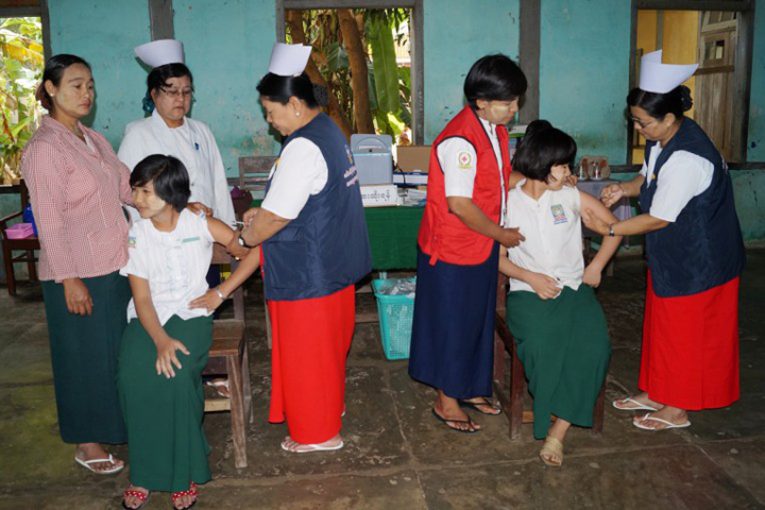Measles is an airborne disease which spreads easily through the coughs and sneezes of infected people. It may also be spread through contact with saliva or nasal secretions and sharing living space with an infected person.
Myanmar faced the outbreak of measles once in 2011 and 2012, and in 2013 measles infection occurred 15 times among the youngsters between 18 and 20 years. The infection was worse in border areas were vaccination programs were weak. As there were signs of the possible outbreak of measles and German measles in 2015 in Myanmar a new vaccination program was launched in the whole country with energetic efforts.
Vaccination program
The vaccination program was divided into two sectors – school-based program and public-based program. The school-based program involved the vaccination of children from five to 15 years between 19 and 27 January 2015. The public-based program was launched from 19 to 28 February 2015, and vaccinated all the children between nine months and five years and children who missed the first vaccination campaign.
The school-based program gave vaccine to under-15 primary, middle and high school students (including students who had reached 15) of government schools, private schools and monastic education schools. In the public-based program, the vaccine was delivered to all the children of ages between nine months and 15 years, and those who were not vaccinated by the school-based program.
According to the Ministry of Health and Sports, a vaccination program covering children of ages between nine months and 15 years will be launched in highly infected seven townships of Yangon Region.
Vaccine will be delivered through injection at the Health Department offices and gathering points of wards in the seven highly infected townships – Hlainethya, Shwepyitha, Insein, Mingaladon, Dagon Myothit (South), Dagon Myothit (East) and Dagon Myothit (Seikkan) townships.
Because of a major outbreak of measles in Hlainthaya Township in 2016, an emergency vaccination program was launched in five townships – Twantay, Insein, Kyimyindine, Hlinethaya and Thakayta.
The cause of measles
Measles is caused by the measles virus. The virus is highly contagiou and is spread by coughing and sneezing.
“We are delivering injection-based vaccine regularly. We launched additional vaccination programs during the years when the infection rate was high. Mothers or guardians should willfully let their children to be inoculated with vaccine during the campaigns,” said Dr Aung Naing Oo, Assistant Director of Public Health Department.
A vaccination program will be launched on a national scale in November and December this year. Records showed that 1276 persons were suffering from measles in the entire country in 2018.
“We never inject children who are allergic to the vaccine or unhealthy,” Dr Aung Naing Oo explained.
The Health Department launched an emergency vaccination program in August 2016 in Naga Self-Administered Zone where measles was broke out. The outbreak even killed people in the villages of Lahe and Namyun townships of Naga Self-Administered Zone.
Elimination of measles
A special vaccination program covering Kachin, Kayah and Rakhine states and Wa and Kokang areas apart from Naga area where the vaccination campaign was weak was launched. Myanmar adopted a project to wipe out measles and control the inborn German measles totally in 2020. UNICEF, World Health Organization, UN, US Red Cross and US Disease Control Centre are the frontrunners in implementing the project.
Children who are not vaccinated are prone to measles and sequel diseases. Vaccine must be delivered to a child when he reaches nine months for the first and for the second time when he reaches the age of 18 months. Myanmar started the measles vaccination program in 1978.
Myanmar launched the mass vaccination program three times from 2002 to 2004, and another three times in 2017. Vaccine was delivered in the places hit by Cyclone Nargis in 2008.
Full course of vaccination
According to a research paper submitted at the Myanmar research conference, 45 per cent of children between 12 months and 23 months fail to undergo full course of vaccination. Of them 32.5 percent are in urban areas and the remaining 49.6 percent are in rural areas. Among the states and regions, Ayeyawady Region has the largest number (over 66%) of non-vaccinated children.

The Ministry of Health and Sports has launched the hospital-based vaccination program for the children who were not vaccinated for various reasons. The program is being launched in 90 over-100-bed hospitals with the goal of giving full course of vaccination to children and ever availability of the vaccination campaign.
Additional program
An additional vaccination program will be launched in Insein, Hlinethaya, Shwepyitha, Dagon Myothit (Seikkan), Dagon Myothit (South), Dagon Myothit (East) and Mingaladon where measles epidemic occurs. Nearly 600,000 children between nine months and 15 years will be given vaccine.
Normally over 10 per cent of children failed to take the vaccine in accord with the course, and in some cases it exceeds 15 percent, said the program manager Dr Htar Htar Lin. The Ministry of Health and Sports will implement the Outbreak Response Immunization soon after the start of the nation-wide mass immunization program.
In Myanmar, there are children who miss the vaccination programs or who fail to take the complete course of vaccine. All parents or guardians should pay attention to the announcements and campaigns of the Ministry of Health and Sports.
(Translated by TMT)



